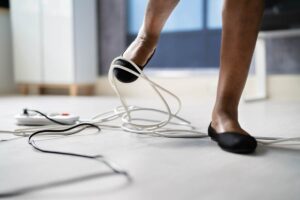A home should be a place of comfort and safety. Safe Electricity encourages you to take care of your home to make sure it stays that way, especially when it comes to electricity.
According to the National Fire Protection Association (NFPA), an estimated 47,700 home structure fires reported in the U.S. in 2011 were due to electrical failure or malfunction, resulting in 418 civilian deaths, 1,570 civilian injuries, and $1.4 billion in property damage.
Take steps to keep your family or yourself out of these statistics. Help prevent accidents by identifying possible safety problems before they occur.
Use the following checklist to help find possible issues with your electrical system or appliances before they start a fire or become a hazard in your home:
- Electrical outlets – Check for loose-fitting plugs. Replace missing or broken wall plates so wiring and components are not exposed. If you have young children, check that unused outlets are covered with safety caps or installed with tamper resistant outlets (TROs). TROs have a built in safety feature that won’t allow any object in the outlet except for electrical plugs. If an outlet is not working, it may be an indicator of unsafe wiring. Have an electrician check it out.
- Ground Fault Circuit Interrupters (GFCIs) – Make sure GFCIs are installed in your kitchen, bathrooms, laundry, workshop, basement, garage and outdoor outlets. GFCIs help protect against electrical shock. Test them monthly to ensure they are working properly.
- Plugs – Never force plugs into outlets. Do not remove the grounding pin (third prong) to make a three-prong plug fit a two-conductor outlet. Avoid overloading outlets with adapters and too many appliance plugs.
- Cords – Make sure cords are not frayed or cracked, placed under carpets or rugs, tightly wrapped around any object, or located in high traffic areas. Do not nail or staple them to walls, floors, or other objects.
- Extension cords – These are not intended as permanent household wiring, so use them on a temporary basis only. If you find you need more circuits, talk to an electrician about installing more so you will not need to use extension cords.
- Light bulbs – Check the wattage to make sure light bulbs match the fixture requirements. Replace bulbs that have higher wattage ratings than recommended on the fixture. Make sure they are screwed in securely so they do not overheat.
- Appliances/Electronics – If an appliance repeatedly blows a fuse, trips a circuit breaker, or has given you an electrical shock, immediately unplug it and have it repaired or replaced. Look for cracks or damage in wiring and connectors. Use surge protectors to protect expensive electronics. Make sure your appliances and electronics are placed in dry locations. If an appliance has been water damaged, be sure to replace it.
- Arc Fault Circuit Interrupters (AFCIs) – Consider having AFCIs installed in your home. An AFCI is installed in a circuit breaker and monitors the flow of electricity throughout your home. If the AFCI detects any abnormality, it will shut the system off, preventing a fire.
- Electrical wiring – Check for loose wall receptacles, loose wires, or loose lighting fixtures. Listen for popping or sizzling sounds behind walls. Immediately shut off, then professionally replace light switches that are hot to the touch and lights that spark and flicker.
- Circuit breakers/fuses – Check that circuit breakers are working properly. Fuses should be properly rated for the circuit they are protecting.
- Service capacity – As you continue to upgrade your home with more lighting, appliances, and electronics, your home’s electrical service capacity may become overburdened. If fuses blow or trip frequently, you may need to increase the capacity of your electrical service or add new branch circuits. A qualified electrician can determine the appropriate service requirements for your home.
For more information on electrical safety in your home, visit SafeElectricity.org.








